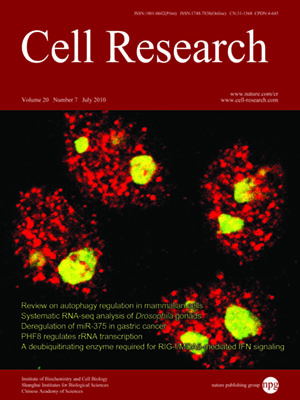
Volume 20, No 7, Jul 2010
ISSN: 1001-0602
EISSN: 1748-7838 2018
impact factor 17.848*
(Clarivate Analytics, 2019)
Volume 20 Issue 7, July 2010: 826-837
ORIGINAL ARTICLES
Potassium channel α-subunit AtKC1 negatively regulates AKT1-mediated K+ uptake in Arabidopsis roots under low-K+ stress
Yi Wang1,*, Liu He1,2,*, Hao-Dong Li1,3, Jiang Xu1,4 and Wei-Hua Wu1
1State Key Laboratory of Plant Physiology and Biochemistry (SKLPPB), National Plant Gene Research Centre, College of Biological Sciences, China Agricultural University, no. 2 West Yuan Ming Yuan Road, Beijing 100193, China
2National Institute of Biological Sciences, Beijing 102206, China
3Department of Biochemistry, University of Alberta, Alberta, Canada
4Crop Science Research Institute, Chinese Academy of Agricultural Science, Beijing 100081, China
Correspondence: Wei-Hua Wu,(wuwh@public3.bta.net.cn)
Potassium transporters play crucial roles in K
+ uptake and translocation in plants. However, so far little is known about the regulatory mechanism of potassium transporters. Here, we show that a
Shaker-like potassium channel AtKC1, encoded by the
AtLKT1 gene cloned from the
Arabidopsis thaliana low-K
+ (LK)-tolerant mutant
Atlkt1, significantly regulates AKT1-mediated K
+ uptake under LK conditions. Under LK conditions, the
Atkc1 mutants maintained their root growth, whereas wild-type plants stopped their root growth. Lesion of
AtKC1 significantly enhanced the tolerance of the
Atkc1 mutants to LK stress and markedly increased K
+ uptake and K
+ accumulation in the
Atkc1-mutant roots under LK conditions. Electrophysiological results showed that AtKC1 inhibited the AKT1-mediated inward K
+ currents and negatively shifted the voltage dependence of AKT1 channels. These results demonstrate that the 'silent' K
+ channel α-subunit AtKC1 negatively regulates the AKT1-mediated K
+ uptake in
Arabidopsis roots and consequently alters the ratio of root-to-shoot under LK stress conditions.
Cell Research (2010) 20:826?37. doi: 10.1038/cr.2010.74; published online 1 June 2010
Cell Research (2010) 20:826-837. doi: 10.1038/cr.2010.74; published online 1 June 2010
FULL TEXT | PDF
Browse 2085


